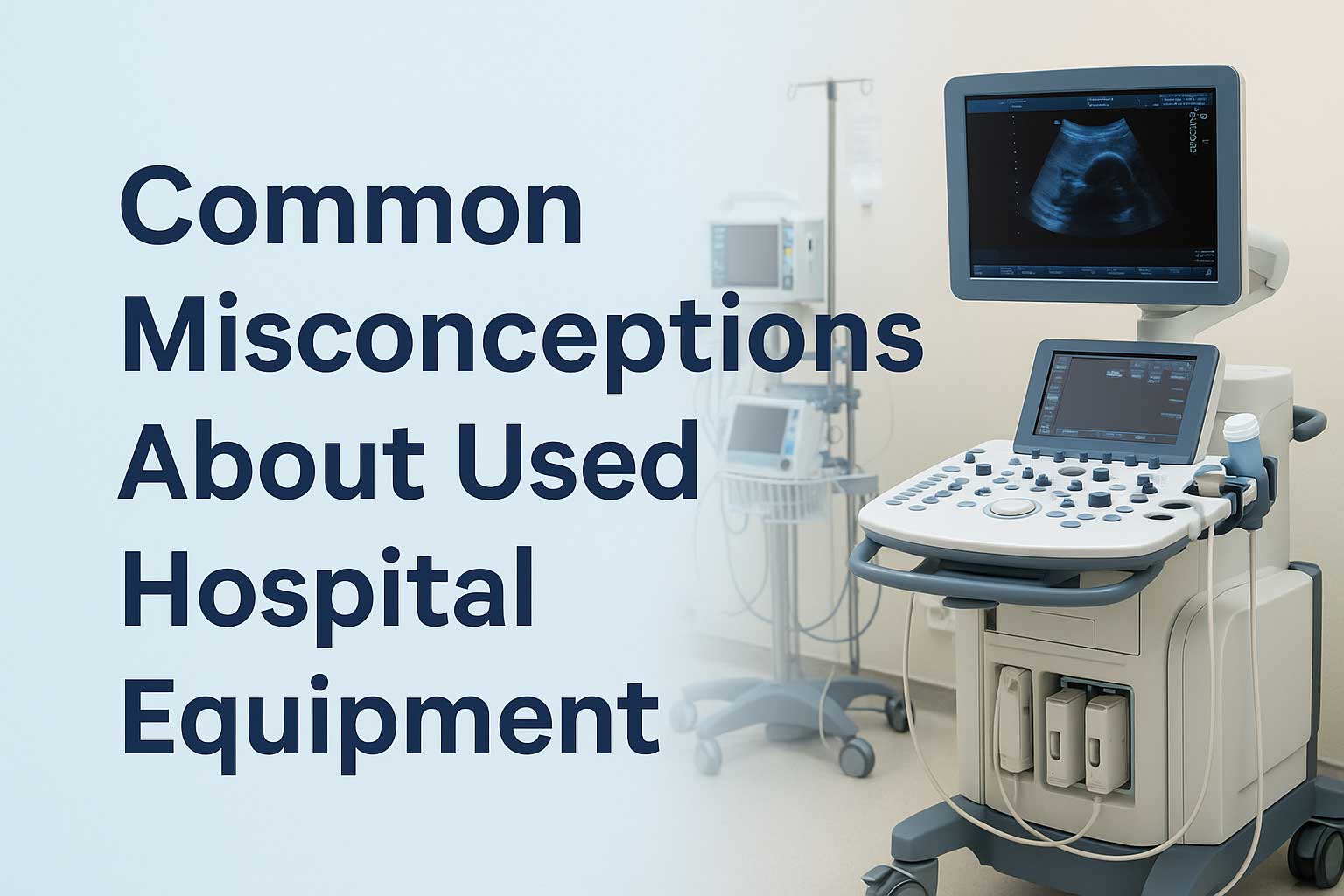Buying pre-owned or refurbished medical devices can be safe, compliant, and budget‑smart—if you know what to look for.
Introduction
Across hospitals, surgery centers, and clinics, used hospital equipment helps organizations expand care capacity without sacrificing safety or outcomes. Yet hesitation persists due to misunderstandings about quality, compliance, and long‑term costs. This article debunks the biggest myths and gives you a practical framework to evaluate refurbished medical devices with confidence.
Myth 1: “Used equipment is unsafe.”
Safety concerns are valid—but the risk isn’t about “used” versus “new.” It’s about process and provenance. Reputable refurbishers follow documented procedures to bring devices back to manufacturer specifications.
The Reality
- Multi‑point inspection & testing: Electrical safety tests, calibration, functional verification, and replacement of worn components.
- Quality management: Suppliers with ISO‑aligned systems and device histories reduce risk and improve traceability.
- Documentation: Test reports, calibration certificates, and service logs verify condition at handover.
Pro tip: Ask for a copy of the refurbishment protocol and the exact tests performed for the specific model you’re buying.
Myth 2: “Refurbished means outdated.”
Many pre‑owned systems are replaced during fleet refresh cycles—not because they’re obsolete. Refurbishment can include OEM‑grade parts, firmware updates, and software upgrades, keeping devices clinically relevant.
- Imaging (e.g., ultrasound, C‑arms) can receive probe replacements, software updates, and new peripherals.
- Patient monitoring can gain connectivity modules and EMR integrations.
- Infusion and anesthesia devices are recalibrated to original specifications.
Ask your supplier for a configuration sheet showing installed options and upgrade paths.
Myth 3: “Used costs more in the long run.”
When you consider Total Cost of Ownership (TCO)—purchase price, warranties, maintenance, uptime, consumables, and resale value—refurbished equipment frequently wins.
TCO Drivers That Favor Refurbished
- CapEx savings: Commonly 30–70% lower than new, freeing budget for training or additional units.
- Predictable service: Service contracts and PM schedules stabilize operating costs.
- Parts availability: For popular platforms, parts and accessories are widely available at competitive prices.
Model the TCO for at least 3–5 years and include estimated downtime costs—reliable refurbished systems often deliver superior ROI.
Myth 4: “Only low-budget clinics buy used.”
Top hospitals routinely blend new and refurbished assets to optimize budgets, speed deployment, and match device capability to the clinical need. It’s a portfolio strategy, not a compromise.
- Use new for leading‑edge modalities where technology changes rapidly.
- Use refurbished for well‑established categories with predictable performance.
- Expand coverage (e.g., extra monitors, backup ultrasound) without delaying care.
Myth 5: “There’s no warranty or support.”
High‑quality suppliers provide warranties (often 6–24 months), installation, user training, and optional service contracts with defined response times.
- What to require: Written warranty terms, covered components, labor, loaner policy, and SLA.
- Onboarding: Delivery, installation qualification, calibration, and basic user training included.
- After‑sales: Hotline support, spare parts stock, and PM reminders.
Myth 6: “Used devices can’t be certified.”
Refurbished devices can be re‑certified for clinical use when brought back to spec and documented properly. Expect calibration certificates, electrical safety test results, and compliance records suitable for audits.
For regulated environments, ensure the supplier aligns with relevant local and international standards and can provide the device history file for your unit.
Benefits of Quality Refurbished Equipment
- Cost Efficiency: Acquire more capacity within the same budget.
- Rapid Deployment: Shorter lead times than ordering new.
- Sustainability: Extends device life and reduces e‑waste.
- Scalability: Easier to standardize fleets across multiple sites.
How to Choose a Trusted Supplier
Use these criteria to reduce risk and maximize value when buying used hospital equipment:
- Proven Refurbishment Process: Request written SOPs and sample checklists.
- Transparent Device History: Prior ownership, service records, and hours of use.
- Certification & Test Proof: Calibration certificates and safety test reports for your serial number.
- Warranty & SLA: Clear coverage, response times, and loaner availability.
- Parts & Consumables: Confirm availability and pricing for 5+ years.
- Training & Install: Ensure on‑site setup and basic user training are included.
- References & Reviews: Ask for recent customer references in your specialty.
Procurement Checklist (Copy & Use)
- ✔ Model, configuration, and installed options match clinical need.
- ✔ Serial‑number‑specific test reports and calibration certificates provided.
- ✔ Preventive maintenance schedule and service manual available.
- ✔ Warranty terms (duration, coverage, SLA) in writing.
- ✔ Spare parts & consumables availability confirmed.
- ✔ Training, installation, and validation included.
- ✔ Return/DOA policy and acceptance criteria defined.
- ✔ Total Cost of Ownership model reviewed and approved.
Frequently Asked Questions
Is used medical equipment safe for patient care?
Yes—when sourced from a reputable refurbisher that returns the device to manufacturer specifications and documents testing, calibration, and safety checks.
How long do refurbished devices last?
Useful life depends on model and utilization. With regular preventive maintenance, refurbished devices can deliver many years of reliable service.
Will I get a warranty?
Quality suppliers offer written warranties (commonly 6–24 months) and optional extended coverage. Always review what parts and labor are included.
What categories are best to buy refurbished?
Commonly: patient monitors, anesthesia machines, infusion pumps, ultrasound systems, operating tables/lights, and sterilization equipment—mature categories with established parts supply.
How do I verify compliance?
Request serial‑number‑specific documentation: electrical safety tests, calibration certificates, software/firmware versions, and maintenance logs aligned with applicable standards.
Conclusion
The biggest myths about used hospital equipment—that it’s unsafe, outdated, or more expensive over time—don’t hold up when you partner with a qualified refurbisher and purchase with a TCO mindset. With proper documentation, warranties, and maintenance, refurbished medical devices can match the clinical performance of new systems while unlocking budget for more staff, services, and sites.
Ready to build a reliable, compliant, and cost‑effective equipment portfolio? Use the checklist above, compare suppliers on evidence—not promises—and choose the solution that best supports your patients and your organization’s long‑term strategy.

